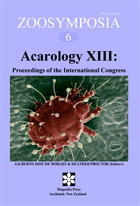Abstract
Spirodiclofen, an acaricide with a novel mode of action (inhibition of lipid synthesis), has recently been commercialized and recommended as a compound that effectively controls mite populations resistant to other acaricides. The efficacy of the spirodiclofen against European red mite [Panonychus ulmi (Koch)] on apple, and two-spotted spider mite (Tetranychus urticae Koch) on greenhouse cucumber was tested in Serbia from 2004 to 2008. Spirodiclofen efficacy was compared to the effectiveness of several other acaricides (bifenthrin, clofentezine, fenazaquin, fenpyroximate) that had been in use for some time. The acaricides were applied at their recommended application rates. Control efficacy against P. ulmi was tested in a commercial apple orchard at Morovic (45°00.711’N; 19°15.146’ E). Applied at the BBCH 09 growth stage (green leaf tips about 5 mm above bud scales) against overwintering eggs, spirodiclofen achieved 89.1 and 86.0% efficacy in evaluations 12 and 25 DAT (days after treatment), respectively. Similar effectiveness was demonstrated for fenazaquin (91.3 and 84.4%), while clofentezine achieved a considerably lower efficacy (67.4 and 27.8%, respectively). In three trials involving the summer population of P. ulmi in three vegetation seasons, spirodiclofen achieved high and steady efficacy: 91% (15 DAT), 97.2% (30 DAT) and 98% (45 DAT) in the first season; 95.2% (14 DAT), 96.3% (29 DAT) and 95.7% (47 DAT) in the second season; and 97.4% (14 DAT), 95.6% (21 DAT) and 97% (38 DAT) in the third season. The highest clofentezine efficacy in the first season was 90.9% (30 DAT), 77.4% (29 DAT) in the second and 68.1% (21 DAT) in the third season. Bifenthrin achieved the highest efficacy in the first season, 78.2% (15 DAT), while it declined to 65.9% (14 DAT) in the second and was practically negligible in the third season. Such unsatisfactory efficacies of bifenthrin and clofentezine were probably the result of resistance development under selection pressure of these compounds at Morovic. The efficacy of fenpyroximate, tested in the second season, was high (97.4%) in evaluations 14 and 29 DAT, but it was only 50.3% in evaluation 47 DAT. Efficacy in controlling T. urticae was tested in a commercial greenhouse in Padinska Skela (44°57.012’ N; 20°25.741’ E). In evaluations 6 and 10 DAT, spirodiclofen achieved 98.4 and 96.8% efficacy, while clofentezine effectiveness was 95.4 and 93.4%, and bifenthrin efficacy 96.5 and 98.8%, respectively. The results showed that spirodiclofen is effective in controlling European red mite on apple and twospotted spider mite on cucumber, and a good alternative to older acaricides.

